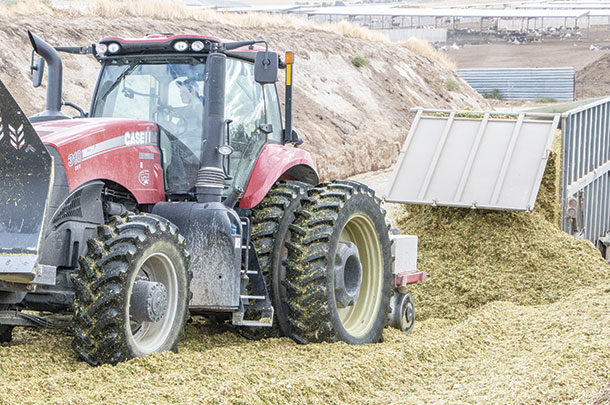Efficient fermentation (rapid drop in pH by conversion of sugars to acids) and storage of wet forages preserves nutrients, which are the cornerstone of a cost-effective diet that helps maintain a healthy bottom line.
As a nutritionist, I work with many dairies on best practices for storing their valuable corn silage crop. In short, we want to chop, pack and seal silage to preserve a high-quality feedstuff through proper fermentation and management. Sounds easy, right? It’s really not hard, but it’s critical to do the basics correctly.
High-quality corn silage in the making
The corn silage you store at harvest and what you feed months later can be very different in nutrient content. Your job is to minimize the quality and volume lost. Fermentation is a simple chemical process. In the presence of anaerobic bacteria, sugars in the fresh corn silage are converted into acids that lower the pH and preserve the mass. The acids keep yeasts and molds from growing, preserving the remaining digestible nutrients for the cows. Efficient fermentation requires these key components:
-
A rapidly fermentable food source – The corn plant’s sugars, some simple starches and soluble fibers fuel the process. Also, at harvest, check equipment settings for kernel processing and chop length.
-
Moisture and heat – The right combination and temperature range is needed for the bacteria to work. Adequate moisture also helps keep oxygen out once it’s initially removed by packing. Keeping heating to a minimum of less than a 20ºF increase over ambient temperature at chopping is important. On the flip side, frozen silage typically will not ferment due to being too cold for the bacteria.
-
As little oxygen as possible – Elimination of oxygen allows the fermentation process to work quickly, limits dry matter losses and reduces chances for spoilage. Oxygen must be kept from re-entering the stabilized silage to maintain the quality and volume of silage long-term.
- A live bacterium (lactobacillus, etc.) – These are the native anaerobes and those applied as an inoculant onto the chopped silage to primarily generate lactic acid – but also acetic and other fermentation acids. It is well-documented inoculants reduce shrink by 2 to 4 percent.
The combination and timing of these elements kick-starts the process and drives rapid fermentation to preserve your corn silage for optimum digestibility and key nutrient availability.
During the fermentation process, your crop’s fiber digestibility will not change much. Neutral detergent fiber digestibility may differ by a few points if you compare samples from harvest and after fermentation. However, starch digestibility will change significantly during the storage process.
The role of moisture and storage
Monitor moisture levels as you prepare for harvest. For quality fermentation, whole-plant moisture should be between 64 and 70 percent at harvesting.
This is essential because adequate internal plant moisture will help keep silage packed tightly, reducing the amount of available oxygen which, in turn, decreases spoilage. With moisture, finding a balance is key.
A moisture level above 70 percent causes some of the most digestible nutrients to leach from corn silage and favors less desirable acid formation, whereas a moisture level below 64 percent limits important acid production needed for preservation and extends the fermentation process. Either situation unnecessarily consumes important digestible starches and sugars, and leaves fewer nutrients for the cows.
The process of removing air from corn silage during packing is critical to rapid fermentation. When unloading into an upright silo or bag, try to pack silage as tightly and quickly as possible to expel oxygen.
Packing tightly via thin layers of 6 inches or less with a goal of 15 to 16 pounds of dry matter and 44 to 48 pounds of fresh weight per cubic foot is extremely important for drive-over piles and bunkers. If possible, use the progressive wedge method to fill the bunker or pile to minimize exposed surface area. Be sure to maintain an adequate slope and a rounded peak to shed water, and then seal it in a UV-resistant, 5-mil or thicker plastic secured with tire sidewalls. Tie tires together to reduce the possibility of them sliding off the pile.
To further reduce dry matter losses, use an oxygen-barrier film under the layer of plastic. When held tightly to the silage surface, an oxygen barrier dramatically reduces surface spoilage 2 to 5 percent and dramatically reduces the dreaded job of removing rotted silage before feeding out. If you are filling a bunker, consider lining the sides with a sheet of plastic or oxygen barrier before packing silage against the walls.
This additional sidewall coverage helps keep external water and oxygen from penetrating the pile and seals the corn silage, further reducing spoilage and dry matter loss.
Fermentation time for corn silage hybrids
After corn silage is packed and stored, make sure the covering is maintained and let it ferment. Once it’s stored, don’t do anything to expose your silage to oxygen until you’re ready to feed it. Giving corn silage four to six months to ferment and for the starches to become significantly more digestible is important for high-producing cows to get the most feed value from it. Although fiber digestibility isn’t affected much over time, starch digestibility can greatly change from six months to a year after being stored.
This change in starch digestibility is due to proteins called prolamins that surround and protect the starch molecules found primarily in the corn kernels. At harvest, prolamins are in place and restrict the cow’s ability to digest the kernels. Through fermentation, acids break down prolamins, making the starch available to the rumen microbes.
Traditionally, producers can feed corn silage with adequate starch digestibility after it ferments at least four months. I recommend you plan to have four to six months of carryover inventory so your new silage crop can have as much time as possible to degrade the prolamin proteins. This is especially important to high-producing cows, which typically have the highest dry matter intake and the fastest rumen passage rate.
Depending on your hybrid choice, the desired effect of fermentation can occur quicker than with conventional hybrids. In corn silage made from genetically proven soft kernel technology hybrids, the percentage of dense starch in the kernels is significantly reduced. That makes the starch available quicker – as soon as six weeks after harvesting and storage. With this flexibility in fermentation, you can feed your new corn silage sooner and potentially maintain lower silage carryover inventories.
Your bottom line
Every little bit counts when it comes to keeping your farm profitable. Correctly managing the fermentation process saves as many nutrients as possible for the cows. And that starts at harvest. On average, in structures similar to drive-over piles, a producer can lose 12 to 15 percent of the overall available nutrients from harvest to feeding.
Keith Bolsen, professor emeritus from Kansas State University, says, “It’s estimated between 16 and 20 percent of the corn silage put up in the U.S. … will be lost. That’s $1.1 to $1.3 billion in feed inventory out the window.” By taking extra care during harvest and quickly and thoroughly packing and sealing your corn silage, you can cut shrink losses into the single digits, preserving digestible nutrients that would normally be lost.
The action you don’t see in your corn silage storage pays off big in the long run. Pay attention to detail at harvest and maximize the value you receive from your silage investment. Work with your nutritionist and agronomist to analyze moisture, chop length, kernel processing and packing at harvest to set your corn silage up for successful fermentation when it comes time to feed. ![]()
PHOTO: Overall, the better you harvest and pack your silage, the more rapidly and efficiently fermentation occurs. This will save you from spending extra money on additional silage inventory or supplements when it’s time to build rations for your herd. Photo by Lynn Jaynes.
References omitted but are available upon request. Click here to email an editor.

-
Phil Krueger
- Nutritionist
- Mycogen Seeds
- Email Phil Krueger











